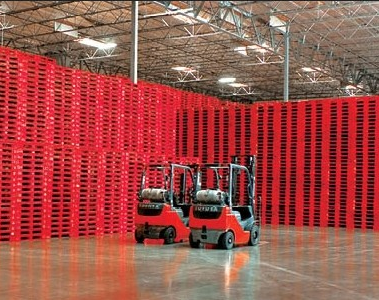Every part of the manufacturing production and management software, warehouse and distribution process is now under scrutiny. The search for lower costs, higher sustainability and greater safety is now transforming the pallet industry. If you are still using wooden pallets, here are 6 reasons why now is time to make the shift to plastic shipping pallets.
1. Ease of Transportation
Plastic pallets are typically lighter than their wood counterparts. So, this means less wear and tear on the equipment you use to move or transport them. In addition, shipping and relocating plastic pallets is lighter, so will cost less in transportation fees.
2. Lower Total Cost of Ownership
Wooden pallets tend to splinter, crack and absorb water in humid environments. They frequently break, so require a labor resource to fix or repair. Wooden pallets’ multi-piece construction is not always automation friendly, which is increasingly an issue. Plastic shipping pallets can be picked up by a forklift from four sides, instead of just two, helping to create other automation or process efficiency. At best, it causes delays or programming modifications, which can cost more to manage over the long term. While plastic pallets have a higher initial cost than wooden ones, over the total lifetime of the pallet, plastic ones cost less.
3. Higher Customer Satisfaction
One attribute of plastic pallets is consistency in shape and form, and a lack of splinters or damage that can impact the goods that are stored or being transported on them. In any of these cases, a deformed pallet that damages the goods they should be supporting and protecting will undoubtedly lead to a poor customer experience.
4. Better Sustainability / Green Factor
Plastic pallets have a more durable and longer life span. That means they will last longer. A typical wooden pallet has a lifespan of only 3-5 years; a plastic pallet can last up to 10 years, or 250 trips, provided they are loaded according to specifications, and that environmental temperature regulations are followed. As an indication of how much more durable a plastic shipping pallet is, there is an active market for used plastic pallets. And, leasing options exist, which doesn’t make as much sense for wood products. Industries that benefited from switching to plastic pallets in Sydney include food, mattress, dairy, wine & spirits, chemical, flooring, export, steel, electrical, appliance, baking, material handling and packaging industries.
5. More Sanitary
Choosing plastic shipping pallets is a more sanitary choice, given that they don’t rot and can be washed with high pressure hoses. By sanitizing them between uses, the chance of cross-contamination is minimized, helping to reduce the spread of food borne illnesses like Salmonella, E. coli, or Listeria. Plastic pallets have smooth surfaces so are more “cleanable”; many offer flow-through design for easier washing. Alternatively, as wood pallets are more porous, they require periodical fumigation or heat treatment to comply with ISPM-15. These treatments further damage wood pallets, thereby shortening their lifespan.
6. A Safer Option
On average, a wood pallet has about 150 nails in it. A loose rusty nail or splinter can damage and even contaminate packed foods. And, they can be a source of injury, lost labor time or a painful infection. There have been cases where companies shifted to plastic pallets as their customers refused shipments that arrived on damaged wooden pallets, due in part to safety concerns. Plastic pallets, on the other hand, are produced by injection molding, as a single piece with no links or nails required. Virtually impossible to splinter or crack under normal load conditions, they are also impervious to insects, rodents and fungus growth. Better stacking ability means it is less likely a stack of plastic pallets will fall over, potentially causing injury.
Timber has historically been considered a prime material for shipping pallets for more than a century. It was affordable, readily available, and well understood. Change is often difficult. Most would like to avoid it, at all costs. However, in today’s world of manufacturing transformation, change is the norm, rather than the exception. New processes, methodologies, materials and concepts are now being embraced as the global competition manufactures operate in now dictates it. Today, it is become clear that plastic shipping pallets have so many advantages that their initial higher price is quickly compensated by durability, life span, re-usability and an unbelievable ROI.
What do you think? I welcome your feedback, if I have missed anything!
If you liked this article, then here are a few others you might also enjoy:
